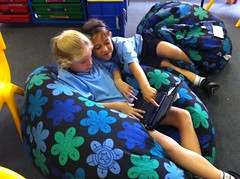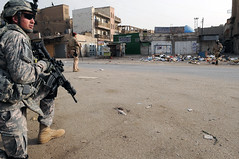Below is an activity written by Amy Alsup, a Ph.D. student at the University of Minnesota. The activity utilizes a clip from The Wire to teach about crime and deviance.
Turf War: The Wire: Season 2, Episode 8 “Duck & Cover” (10 minutes 13 seconds)
Location: YouTube: (http://www.youtube.com/watch?v=8HmPZyrGGdk&feature=related)
Scene Description:
“At the Towers, Bodie organizes his crew to arrive at the disputed corner at 7 a.m., in order to beat their rivals to the spot. They bring guns and bats and when the other dealer finally shows, he threatens Bodie: “You gon’ see me in your sleep.” The other gang leaves, but Bodie knows they’ll be back.”
From: http://www.hbo.com/thewire/episode/season2/episode21.shtml
This scene illustrates a turf war that occurs between two rival gangs in Baltimore. Members of the Barksdale crew, featured at the beginning of the scene, find rival gang members dealing drugs on the block that they normally occupy. After a brief confrontation, a gunfight ensues. A shot is fired through the window of an apartment building, where a mother finds her son dead on his bedroom floor. Stringer Bell, who is running operations while gang leader Avon Barksdale is in jail, is angered by the carelessness of his crew and orders Bodie to take a time-out. Bodie and his crew dispose of the guns by dumping them in the water.
This clip could be used to discuss crime, police surveillance, drug wars, gangs and general difficulties and hardships of life in impoverished communities. The rival gang scene could be shown to introduce the politics of the underground drug economy. It would provide an excellent introduction to a lecture, discussion or active learning exercise about social conditions which lead to criminal activity and the consequences of crime on the wider community.
Active Learning Exercise Idea:
Begin class with a brief lecture on theories of crime and deviance and social conditions in impoverished communities that lead to criminal activity. Show the clip and have students break up into small groups to discuss what actions they would take to improve conditions in this community.
Ask students to (1) identify and list five problems in the Baltimore community (ie: drug dealing, gun violence, poverty, dangerous conditions for children, etc). (2) Discuss 5 ways in which these problems could be prevented.
Then, have the full class congregate once again. Have one representative from each group write the problematic conditions in the community on the board and then return to their seats. Go through the list of problematic conditions in the community. Ask students:
- Are these personal troubles or sociological issues? (For students who are unfamiliar with C. Wright Mills, this can be rephrased as: “Are these problems in the community psychological? social? local? global?”)
- What caused these problematic conditions in the community? Do you think problems arise due to cultural factors, social inequalities, or individual decisions? Why?
Then, ask students to identify the solutions they provided. Challenge students to use theories about crime and deviance to rationalize their choices.


 Prostitution is one of those topics that incites very strong reactions–making it very difficult to discuss in the classroom. In the
Prostitution is one of those topics that incites very strong reactions–making it very difficult to discuss in the classroom. In the 




